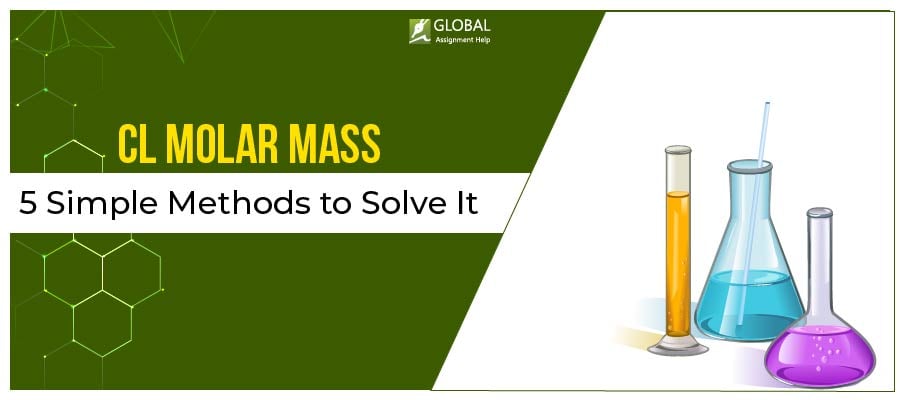Table of Contents
When we are solving a chemistry problem, it sometimes seems tougher than it already is. One such problem is calculating Chlorine’s molar mass (Cl) or its compound, Cl2. Though they may seem complicated, you don't have to worry! Because we'll make it easier for you in this blog. So, if you're looking for help with your chemistry homework, we've got you covered. By the end of this post, you'll be able to calculate the molar mass of cl2 effortlessly.
However, it is essential to know about the Chlorine and its uses before we discuss Chlorine's molar mass.
A Brief About the Chemical Element Cl & Its Uses
Chlorine is a chemical element known as Cl that can be found on the periodic table. It is a pale green gas with a strong and distinct odour. It is used for many purposes due to its chemical properties. Now, to answer, what is the molar mass of cl2? The molar mass of cl2 is approximately 35.45 grams per mole. Molar mass means the mass of one mole of a substance.
Uses of Chlorine (Cl)
We all know that chlorine is highly reactive chemical. And it is known for its disinfecting properties. Therefore, it is best to use this chemical element for purifying water in swimming pools and treating drinking water to remove harmful bacteria. Moreover, it can produce various chemicals, like bleach, PVC, etc.
Chlorine is also often utilized for manufacturing plastics, paper, and many other products. Though, it has multiple uses, it is vital to handle it with care as because of its toxicity. Moreover, chlorine can harm humans and animals in many ways, when it is In its gaseous form.
Now that we have discussed a brief about Chlorine let's learn about its physical properties.
Physical Properties of Chlorine
Here, we are discussing the physical properties of Chlorine that you should learn about before learning how to calculate Chlorine molar mass.
Color and Odour: Its a pale greenish-yellow gas with an irritating odor. Its color and smell make it easily recognizable. It
State at Room Temperature: This chemical element is a diatomic molecule (Cl2) in its natural state, existing as a gas at room temperature and atmospheric pressure.
Density: It is said to be denser than air, so it accumulates near the ground when released. Its density is about 3.2 times that of air.
Boiling and Melting Points: Chlorine has a low boiling point of -34.04 degrees Celsius and its melting point is -101.5 degrees Celsius which make it easy to handle. Moreover, it can be stored as liquefied gas in cylinders.
These are some physical properties of Chlorine. However, if you still face difficulty, getting chemistry assignment help from experts is best.
Chemical Properties of Chlorine
It may seem challenging to understand the properties. However, it is essential for you to know these, as it can help you calculate the molar mass of the Chlorine more effectively.
Reactivity: It is a highly reactive element. It readily forms chemical compounds with other elements. Moreover, it's known for its strong oxidative properties. Chlorine can also react with substances like metals, organic compounds, and a few non-metals.
Bleaching Agent: Chlorine is used as a bleaching agent in the paper and textile industries. It can remove color from substances by breaking down their pigments and dyes.
Formation of Chlorides: It can combine with metals to form metal chlorides. For example, it forms sodium chloride (table salt) when reacting with sodium.
Toxicity: This chemical element is a highly toxic gas. So, if you put it in constant exposure to high concentration, it can harm your health. As it causes irritation to the eye and skin and respiratory problems.
Now that you have learned about Cl's physical and chemical properties, it is time to know the five simple yet best ways to calculate the molar mass of Cl2.
5 Simple Ways to Calculate the Molar Mass of Chlorine
Calculating the molar mass of Chlorine (Cl) can be done in several ways, and each method offers its unique advantages. So, we have summed up five quick and easy ways to determine the Cl molar mass
Way 1: Using the Periodic Table
The most simple method is to refer to the periodic table. Find Chlorine (Cl) on the table, and you'll see its atomic mass, approximately 35.45 grams per mole (g/mol). This value represents the molar mass of a single chlorine atom.
Way 2: For Cl2 (Diatomic Molecule)
If you're dealing with Cl2, a diatomic molecule, simply multiply the atomic mass of Chlorine by 2. This accounts for the two chlorine atoms in each molecule.
For example: For the molar mass of Cl2, it is approximately 2 * 35.45 g/mol = 70.90 g/mol.
Way 3: Using Chemical Formulas
It is best to use chemical formulas for Chlorine compounds. All you have to do is calculate the molar mass by summing up the atomic masses of all the elements in the compound.
For example: In HCl, the molar mass is the sum of hydrogen's (H) atomic mass and Chlorine (Cl). So, HCl has a molar mass of approximately 1.01 g/mol (H) + 35.45 g/mol (Cl) = 36.46 g/mol.
Way 4: By Percent Composition
If you know the percent composition of Chlorine in a compound, you can calculate the molar mass using it.
For example: If a compound is 63.5% chlorine, the remaining 36.5% must be from other elements. Calculate the molar mass by multiplying the percent composition by the atomic mass of Chlorine and the other element(s), then sum these values.
Way 5: Using Avogadro's Number
Avogadro's number is this: (6.022 x 10^23). It is the number of particles in one mole of a substance. So, you have to count the number of atoms of each element in one mole of the substance and sum their atomic masses, to find the molar mass of Chlorine.
For example: You have 2 moles of chlorine atoms in one mole of Cl2, so the molar mass Cl2 is 2 * 35.45 g/mol = 70.90 g/mol.
By using any of these ways, you can easily calculate the molar mass of Chlorine, whether you're dealing with a single atom or a compound containing chlorine atoms. It's a fundamental skill in chemistry crucial for various calculations and understanding the properties of substances. We have also given an example in the next section so that you can understand it more clearly.

An Example of Solving a Question Using Cl Molar Mass
Here’s an example of solving a question using the molar mass of Chlorine (Cl).
Question: How many moles of sodium chloride (NaCl) are formed when 20 grams of sodium (Na) reacts with excess chlorine gas (Cl2)?
Solution: Now you have to calculate the molar mass of sodium chloride (NaCl): It's approximately 58.44 g/mol.
Firstly, find the number of moles of sodium (Na): Around 0.870 moles.
Use the balanced chemical equation (2 Na + Cl2 → 2 NaCl) to determine that the number of moles of sodium chloride formed is also approximately 0.870 moles.
So, when 20 grams of sodium reacts with excess chlorine gas, approximately 0.870 moles of sodium chloride are formed.
So basically, determining the molar mass of Cl or its compounds, like Cl2, is a fundamental skill in chemistry. Using these quick and easy methods we've discussed, you can easily find the molar mass of cl2 in no time. Understanding molar mass is essential for various chemical calculations, whether dealing with a single chlorine atom or a diatomic molecule. So, don't hesitate to use these simple techniques in your next homework. However, in case of confusion, you can always seek chemistry homework help from our professionals.
Still Need Help with Calculation Molar Mass? Seek Help from Us
Are you still unclear about the concepts? Do you feel like you don't know how to calculate the molar mass of cl2 or have questions about its properties? Then, don’t worry! Try seeking help from our experts, who specialize in chemistry and can provide guidance and explanations tailored to your specific needs.
So, our experts can assist you if you are struggling with this or any other chemistry problem. Don't hesitate to reach out for valuable homework help.They will walk you through the process step by step, ensuring you clearly understand the topic.
Free Tools

Easy to Use Paraphrasing Tool to Simplify Complex Academic Writing
Check Now
Get Structured Outline by Professionals for Your Dissertation
Check Now
Effortlessly manage citations and references with our smart referencing tool
Check NowPrice Calculator
- Plagiarism
- Pricing
- Order Now
- Call Back
- Live Chat

Limited Time Offer
Exclusive Library Membership + Free 300$ Wallet Balance

Get $300 Now
Update your Number





























Thank you for submitting your comment on this blog. It is under approval. We will carefully review your submission and post it on the website.